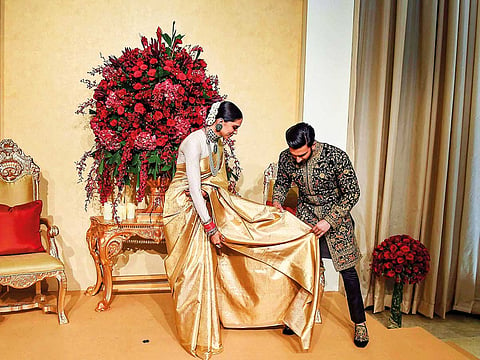I am not the regular ‘Sari’ person
I still get jitters when someone asks me to wear a Sari

Draping a Sari is a complex and the most difficult task, if you ask me. When I have to a wear a Sari, I start getting tense. Weeks before the event, I have nightmares. It takes me hours to wear the Sari. Even visiting the loo is difficult wearing a Sari.
The problem with a Sari is that, not only is the draping tough, but we must also look for a matching blouse, Sari falls, and an underskirt. To embellish it, furthermore, add matching bangles, a matching necklace, and matching Bindi (Pottu)- the coloured dot that Indian ladies adorn on their foreheads.
I am not the regular ‘Sari’ person. Given a choice, I would prefer going in casuals even to a wedding, where ladies usually wear Kanjiwaram, Benarasi or glittery Sari with sequins on them.
To tie a Sari is an art, the Pallu (the part of the Sari that hangs over your shoulder), the neatly made-up pleats tucked inside your underskirt and finally perfecting it by pinning them up at the right places. Hats-off to the women who wear it daily.
A friend of mine loves saris and has a ginormous collection and apt accessories to go with them. She wears a Sari for any occasion. Every Navratri, she posts her photographs in different coloured saris meant for that day. The ease with which she sits or moves around in a sari is commendable.
Just the other day I opened YouTube to learn how to drape a Sari. Ladies are so innovative at tying the Saris that in one video she showed how to drape it in six different ways. Saris are worn not only with innumerable styles of blouses but even with Kurtas or Kurtis.
Different varieties of Saris
I learnt that Sari is no longer a Sari - ladies wrap it around into a gown, it becomes an add on to your lehenga or even becomes a sarong dress. I can imagine the traditional aunties yelling “What are they wearing? Nothing is covering, everything is showing, and they call it a sari! In our time’s girls used to dress decently, look at these girls now, appa!!”
I am amazed at the different varieties of Saris available in India. From Kanjeevarams, Pathanis, Banarasi, Patola, Jamdani, Bomkai, Kota to a simple cotton Sari.
Watching the weavers weave dexterously and skilfully, a beautiful Sari is breathtaking. They painstakingly weave a Sari using the required colourful yarns. A typical Kanjivaram Sari contains borders and a grand Pallu with beautiful motifs. There are so many varieties of handloom weaves. Every weave is unique, its style, its texture, its pattern, and its colour combinations.
People from Tamil Nadu, Iyers and Iyengars in particular, wear a nine-yard Sari called Madisar. Ladies from Maharashtra wear a similar long drape called the Nauvari. Rani Lakshmi Bai fought against the British in this Nauvari Sari. And I worry about the six -yard Sari!
I remember both my grandmothers used to wear Saris at home. The Saris worn at home were predominantly cotton, which my grandma used to starch religiously. The old Saris were often made into swings for babies. They used to wear silk Saris during festivals, weddings, and other occasions.
In some traditional houses, girls are scorned upon for wearing jeans and are forced to wear Saris. Any dress can be provocative as well as decent. It depends on the person, as to how she wants to portray herself. Discarding jeans as inappropriate is unwarranted, at the same time Sari can also be worn in a very seductive manner.
Worn perfectly, a Sari can be graceful and enchanting. Jeans with a top can also look very decent. A Sari can be cumbersome for ladies who are working and need to travel in buses etc, it’s more convenient to wear jeans or a salwar suit.
Whenever I think of Saris, I can only imagine Hema Malini or Sridevi dancing and singing in perfectly draped, elegant, and extravagant Sari. I often wonder how they change their saris so quickly for every stanza of a song.
But even after all this education and watching glamorous and gorgeous ladies dolled up in exquisite Saris, I still get jitters when someone asks me to wear a Sari.
Anuradha Sharma is a freelancer based in Abu Dhabi
Sign up for the Daily Briefing
Get the latest news and updates straight to your inbox



